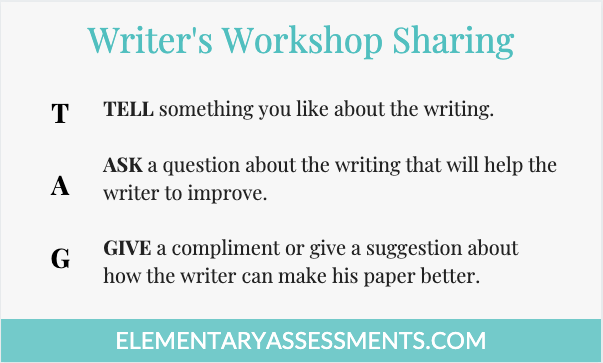The start of the school year means it’s time to set Author’s Chair expectations for writer’s workshop.
Author’s Chair is the final component of writer’s workshop. During this 10-15 minute block, individual students share their writing with an audience of classmates.
After sharing, peers provide structured feedback. This process supports students in their journey towards becoming flourishing writers.
Author’s Chair is a student’s moment to shine, and this block is most successful for students when clear expectations are set early in the year.
During those first few weeks of the school year, establish rules, procedures, and routines that will maximize this precious sharing time.
Additionally, use the following six guidelines to establish strong Author’s Chair expectations in your classroom.
Setting Up Author’s Chair Expectations
1. Establish Procedures for Author’s Chair.
Author’s Chair begins with setting procedures. This is best done as a sequence of mini-lessons during writer’s workshop.
After independent writing and conferencing, students gather on the carpet. They have in hand their writer’s notebook if they plan to share.
All students face the reader, ready to listen.
During the course of a week, everyone shares at least once before any child shares for a second time.
2. Practice Appropriate Behaviors.
Procedures and appropriate behaviors are the core of Author’s Chair expectations.
When students are seated on the carpet, they should be relatively quiet, ready to listen, and not fumbling with any materials or objects.
Model for students what active listening looks like … pencils are down, everyone faces the reader, and body language shows respect.
The reader also has a responsibility.
He or she must face the audience, read clearly, and use a voice volume that is heard by all, especially those seated farthest away.
The student sharing should also possess a positive attitude about receiving feedback from classmates. Students are a community of writers learning from, helping, and supporting each other.
Consider creating an anchor chart with students as a reminder of which positive behaviors to demonstrate during each component of writer’s workshop.
3. Designate a Special Chair.
Designate a “special chair” for sharing time. Examples include a bean bag, rocking chair, “regular” school chair, or the teacher’s desk chair.
A student favorite is a director’s chair!
It’s an investment, but if you can splurge a bit, make the purchase. You could add it to your classroom wish list.
Even the most reluctant writers are motivated by the thought of sitting in the director’s chair.
Say goodbye to hearing “crickets” when it comes to those wanting to share.
4. Have a System For Giving Feedback.
A very important part of Author’s Chair expectations is providing some type of guidance for classmates to give helpful feedback to those that shared.
The T.A.G method works well…
T= Tell something you liked about the writing.
A= Ask a question about the writing that will help the reader to improve it.
G= Give a suggestion about how to make the writing better (or Give a compliment).
Provide prompts such as the following to guide students if needed…
“T” (Tell something you liked.) suggested prompts …
- The way your paper begins is so interesting because…
- I enjoyed the part where…
- I like the details you used to describe…
- Great job with showing and not telling in the part about…
- Your ending was good because…
“A” (Ask a question.) suggested prompts …
- Could you add an example to the part about…?
- Do you think you could leave this part out because…?
- Would you consider adding a lead to “grab” the reader’s’ attention?
- Did you use a checklist after writing?
“G” (Give a suggestion or compliment.) prompts include…
- I love your ending. It was so unexpected and surprising.
- Maybe you could “explode” one moment instead of having a “grocery list” of ideas.
- You could add more details in the part about…
- I got confused in the part about…
- The vivid details you used helped me to clearly visualize the actions in the story.
- I believe I have a stronger alternative for the title. Maybe you should try…
- Your paper is well-organized and flows nicely.
- I think using a stronger verb for ________ would make your writing even more interesting!
5. Record Anecdotal Notes.
Occasionally, when students are sharing, jot down anecdotal notes related to targeted learning objectives.
Take a three-ring binder, section off a section for each student, and informally jot down any significant observations you notice while he/she shares.
6. Communicate a Risk-Taking Environment.
Writing well takes a lot of hard work and includes lots of trial and error.
Communicate early in the year that taking risks with writing is a good thing.
- Are students eager to try new words in their writing?
- Have you noticed a good number of students trying a new lead that they learned from a favorite independent reading book?
Whichever strategies they’re trying, encourage them to take those risks!
You’re Ready to Tackle Author’s Chair Expectations
These Author’s Chair expectations will help set the tone for a great writer’s workshop finale.

